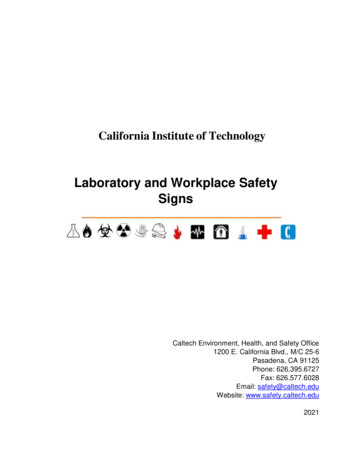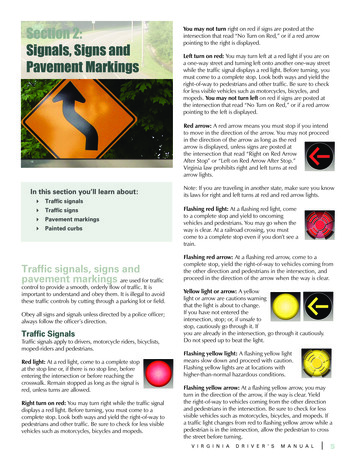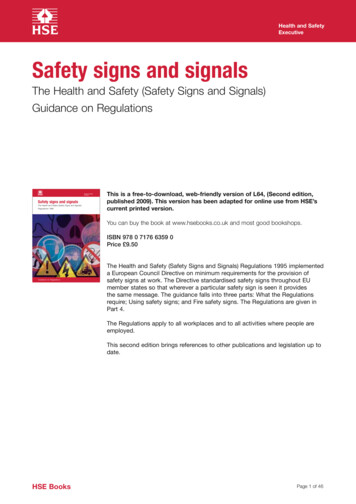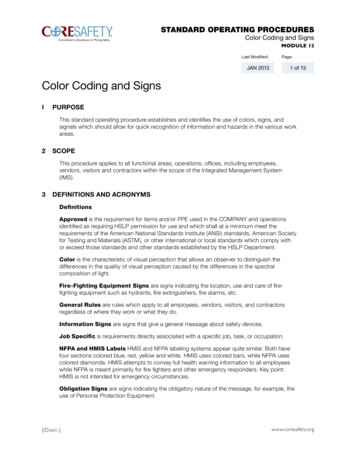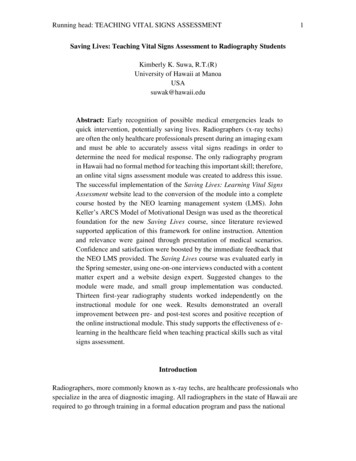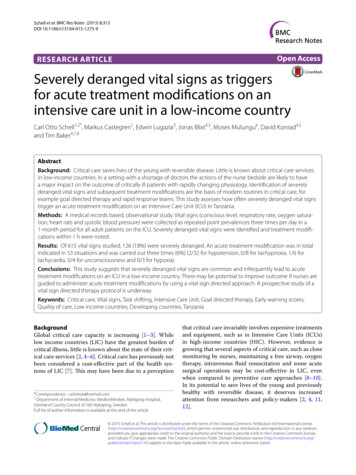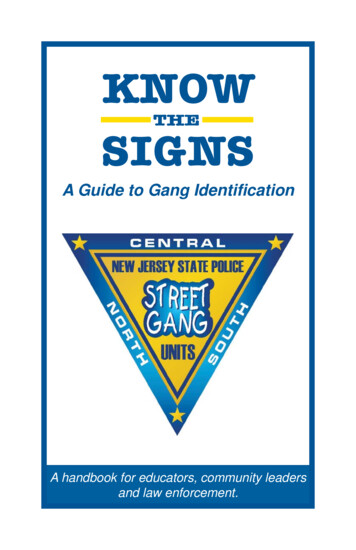
Transcription
KNOWSIGNSTHEA Guide to Gang IdentificationA handbook for educators, community leadersand law enforcement.
ContentsDefinitions .1Gangs in New Jersey .3Common Terms .4Gang Colors and Identifiers .5Clothing . 11Graffiti .13Hand signs.15Symbols .17Folk and People Nation .18Tattoos .19Gang Writing.20Safety Issues .24Guidelines for Preventing Gangs.25Sample School Gang Policy .27Sample Gang/Behavior Contract .30Select New Jersey Gang Legislation .31Where to get help .38
Definitions —New Jersey Criminal Statutes define a gang as:“Criminal street gang” means three or more personsassociated in fact. Individuals are associated in fact if:(1) two of the following seven criteria that indicate criminalstreet gang membership apply: (a) self-proclamation;(b) witness testimony or official statement; (c) writtenor electronic correspondence; (d) paraphernalia orphotographs; (e) tattoos; (f) clothing or colors; (g) anyother indicia of street gang activity; and (2) individuallyor in combination with other members of a criminalstreet gang, while engaging in gang related activity, havecommitted or conspired or attempted to commit, within thepreceding five years from the date of the present offense,excluding any period of imprisonment, one or moreoffenses on separate occasions of robbery, carjacking,aggravated assault, assault, aggravated sexual assault,sexual assault, arson, burglary, kidnapping, extortion,tampering with witnesses and informants or a violation ofchapter 11, section 3, 4, 5, 6, or 7 of chapter 35 or chapter39 of Title 2C of the New Jersey Statutes.(NJSA 2C:33-29)Schools, communities and other organizations may define gangsdifferently than law enforcement agencies in order to addresstheir specific situation.For example:A group of juveniles and/or adults in a geographic area whoseactivities include (but are not limited to) the unlawful use of force,intimidation, and/or threats and violence to further the group’s activities.Additionally, the group should fulfill at least one of the followingcriteria:1.The group must recognize itself as a distinct group (throughsigns, symbols, etc.)1
2.The group must conduct enough illegal activity to get a consistent negative relationship from law enforcement and orlocal school communities3.Community (local and/or school) recognition of the group(Sample school district definition)Keep in mind that gangs can range from large, nationally knownand organized groups (like the Bloods or Latin Kings) that can beactive throughout the country to small, unorganized groups thatdo not venture outside their particular neighborhood. You do nothave to have the Bloods or Crips in your area to have a gangproblem. According to the definitions above, a gang is not evenrequired to have a name. As long as the group has some sort ofcommonality between the members they should be classified asa gang.REMEMBER:Gang members may be of ANY race, socioeconomic background, gender, or age. Thebiggest mistake anyone can make when dealingwith gangs is thinking that gang membersadhere to some stereotype. Increasingly, gangsare spreading to suburban and rural areasand they have few, if any, ties to urban, innercity gangs that most people think of whendiscussing gangs.2
Gangs and New Jersey Over 282 distinct gangs have beenidentified in New Jersey Forty-three percent of all municipalitiesin New Jersey have reported the presenceof gangs in their jurisdictions 43% of all gang members inthe state are under 18 yearsof age Gangs have been reportedactive in rural, suburban andurban areas throughout the state Respondents to the 2004 NJSP Street Gang Surveyestimated that at least 532 gang-related incidents tookplace on school grounds in 2003 The NJ Department of Education reported a decrease ingang fights between the 2004-2005 and 2005-2006 schoolyears, but an increase in the number of assaults, threats,and incidents of harassment, intimidation, and bullying.Sources:2007 New Jersey State Police Street Gang Survey and New Jersey Department ofEducation Violence, Vandalism & Substance Abuse in New Jersey Public Schools2003-2004 Report3
Common Terms —187: Common gang term for murder or violenceADR or Amor De Rey: Latin King affiliationALKN or ALKQN: Latin King affiliationB/K: (Blood Killer) May be seen in a variety of different formsincluding extensive use of products with “BK in their names, i.e.Burger King, British Knights, etc. (Crip affiliation).B.O.S.: Beat on sightBrick City: Newark, NJC/K: (Crip Killer) Same as “B/K” above (Blood affiliation)Crabs: Derogatory term for Crips members by BloodsFolk: Umbrella gang affiliation“G” or “OG”: Refers to the named individual as a ‘gangster’ or‘original gangster.’Gat: GunManito (or Hermanito): Brother or Brother of the Nation (Hispanic gangs)M.O.B.: “Money Over Bitches” or “Member of Bloods”People: Umbrella gang affiliationPhysical: Punishment for a gang member who breaks the gangsrules. Usually a beating by one or members for a set period oftime.Rocking or Representing: How gang members show affiliation for their gang. This may be done by wearing certain clothing,showing hand signs, etc.Slobs: Derogatory term for Bloods members by CripsT.O.S.: Terminate on sightViolation: Punishment for a gang member who breaks the gangsrules. Usually a beating by one or multiple members for a setperiod of time.What’s Poppin’?: Greeting among Bloods members.What’s Crackin’?: Greeting among Crips members4
Gang Colors and Identifiers —Bloods: Colors: Primary colors are red and black. Secondary colors arebrown, pink and green. Cross out “C”s in writing (to disrespect Crips) Refer to each other as “Dawgs” or “Dogz”“Dog Paw”symbol used byBloods members.Usually burnedonto the skinwith cigarettes.5
Gang Colors and Identifiers —Almighty Latin King and Queen Nation (ALKQN): Colors: Gold/Black Use of 3 or 5 pointed crown Use initials ALKN and ALKQN The number ‘360’ has special significance ADR “Amor De Rey” or ‘Love of the King”6
Gang Colors and Identifiers —Crips: Colors: Blue/Black/Purple/Orange/Grey Cross out “B”s and “P”s in writing (to disrespect the Bloods) Refer to each other as “Cuzz”7
Gang Colors and Identifiers —MS-13: Colors: Blue and white Mix of Roman and Arabic numerals (MS-X3, MSXIII, MS13) Old English and Block Lettering font in graffiti/writingOld English8
Gang Colors and Identifiers —18th Street: Colors: Blue ‘Dieciocho’ (‘18’ in Spanish) Mix of Roman and Arabic numerals (XV3, XVIII, 18th) Old English font in graffiti/writingOld English9
Gang Colors and Identifiers —Ñeta: Colors: Red/White/Black or Blue Use Puerto Rican flag extensively The number ‘150’ has special significance10
Clothing —Use of bandannas, beads and hats with gang colors is common.What side of the body these items are worn on may indicate whatgang the individual identifies with. Other indicators may include:rolled up pants leg, oneshoe untied, hats cockedto one side or jewelryworn to one side of thebody.Not all people whoadopt this style andlanguage are members of gangs.Examples of howbandannas may beworn to signify gangaffiliation:11
Clothing may be used to advertise gang affiliation, either throughcolors, team symbols or particular brands.Some gang members will have clothing custom made to advertisetheir affiliation.To avoid suspicion, members may use small items (shoelaces,thread, etc.) to show gang colors.Colored shoelaces used toidentify gang membership.Team colorsand names usedto identify gangallegiance.12
Graffiti —Graffiti may be an indicator of gang activity.Look for: crowns, pitchforks, stars, etc. “ ” indicates narcotics sales names/initialsExample of Latin Kinggraffiti with a fivepointed crown and theinitials A.D.R. (Amorde Rey – Love of theKing). Quest is mostlikely the ‘Tag’ name ofthe person who put upthis graffiti.13
Virtually everything in gang graffiti has some sort ofmeaning.Cross-outs: Indicates disrespect for the crossed out group orindividual. May also indicate that the writer is going to attack thedisrespected person.Bloods 031Example of disrespect tothe Bloods by crossingout their nameWhen you observe graffiti you should:1)Document it. Photograph it and note the time and place itwas discovered.2)Remove it. As quickly as possible, have the graffiti removed.3)Monitor it. Monitor that location for further evidence of gangactivity.The longer graffiti stays up the more graffiti it will attract.Local gangname andsymbol.“Tag,” or nickname ofindividual putting up graffiti.Tag name along with 3 pointcrown that may indicate gangaffiliation.14
Hand Signs —Hand signs are used by gangs to identify their gang and as aform of communication. They may also be “flashed” as a warningor threat to rival gangs. They are often “thrown” quickly, makinginterpretation difficult for the non-expert.Blood KillerWest Coast15
Crip KillerCrip for Life5 Pointed StarLatin King “Crown”Blood HandsignÑeta Handsign16
SYMBOLS —Pitchforks (pointing up or down)Stars (5 or 6 pointed most common)Crowns (3 or 5 pointed most common)17
Folk & People Nations —Folk and People Nations are loose umbrella organizations originally formed in Chicago. Many gangs throughout the nation claimto fall under one of these groupings.It is therefore possible for someone to be a member of a gangand a nation. For example, a member of the Black GangsterDisciples could be a member of that gang AND also a member ofthe Folk Nation.Theoretically, gangs belonging to the same ‘nation’ should be allies and cooperate. In reality however, these bonds tend not tobe particularly strong. It is not uncommon for gangs belonging tothe same nation to be in conflict with each other.Not all gang members belong to the Folk or People Nations (especially the further from the Chicago gang influence they are).Many, in fact may not even be aware of the existence of Folk andPeople even though they may use some of the symbology of thegroups.18
Tattoos —Common themes of gang-related tattoos are: Dogs ‘Thugs’ Gang symbols (crowns, pitchforks, etc.) Lions Money ‘Gangsters’ ‘M.O.B’Dog Paw: Found most commonlyon the right arm. Usually done bycigarette or cigar burns. Favored byBloods members who refer to eachother as ‘dog.’“No Rules 2 Thug Life” Thugs andgangsters are common themes ingang tattoos and literature.19
Gang Writing —Gang members frequently put gang-related information in writing. The more organized the gang, the more rules, oaths, etc. willexist. It is important to remember that most gang members areproud to be in a gang and will advertise their affiliation wheneverthey can. Notebooks, homework, clothing, and anything else thatcan be drawn on should be checked for gang markings. Photocopy everything if you aren’t going to confiscate it.Bloods Code List20
Gang Writing —Members frequently possess gang-related writing which maybe on notebooks, cards, or scrap paper.21
Gang Writing —Many members write their own rap lyrics which describetheir gang and criminal activity.“I roll wit jus G’s, lead the life of a thug / fighten, haten,shootin guns over drugs.”“We protect what’s ours by any means / even if that meansI’m shatterin your dreams / Your ass’ll scream when ourpoison enters your blood stream ”22
Gang Writing —Rules from a gang of intermediate school-age youthLatin King graffiti (Five-pointed crown, yellow & blackcolors of the bee are same colors of Latin Kings)23
Safety Issues —Gang members are known to sometimes carry and use firearms.They also carry and use other types of weapons as well.Blades are sometimes used as weapons by gang members. Boxcutters and razor blades are popular because they are easy toacquire and conceal.Gang members may carry blades in their mouths, hat brims, bandannas, or similar areas.When dealing with suspected gang members:1)Attempt to talk with them individually.Groups of gang members tend to be more uncooperative,unpredictable and dangerous than individual members.2)Don’t refer to the gang as a gang.Many gang members find the term ‘gang’ disrespectful.Other terms frequently used: Set, Nation, Organization, Association, Crew, Clique or Posse.3)Treat gang members with respect.Respect is very important for most gang members. If theythink you respect (as opposed to fear) them you are morelikely to get positive results from them. For example: If youhave a policy against the wearing of bandannas or ‘flags,’you will be showing the member respect by allowing him orher to remove the ‘flag’ and give it to you rather than forciblytaking it from them.4)If you aren’t sure if something is gang related ask.Sometimes gang members will discuss gang informationopenly.24
Guidelines for PreventingGangs —1)Establish good communication with your children. Open, frequent and positive in tone Encourage children to ask questions. Ask your children about gangs in their school and theneighborhood.2)Be aware of what’s going on in your children’s lives. Who are their friends? What do they do when away from school or home? What are their major influences and interests? Monitor their internet use (MySpace, Facebook, etc.).3)Occupy your children’s free time. Get them involved in school, sports, community, orrecreational activities. Give them responsibilities at home. Praise them for doing well and encourage them to dotheir best.4)Set the example. Help your children to identify positive role models andheroes – especially those in your family or community. Demonstrate a ‘zero-tolerance’ policy for ganginvolvement at home or in the community. Do not buy or allow your children to dress in gangstyle clothing.5)Participate in the education of your children. Visit your children’s school, meet their teachers, andattend parent/school meetings.25
Inform your children about the dangers of ganginvolvement.6)Participate in the community. Know your neighbors. Report suspicious groups and graffiti to the localpolice. Talk with other parents and exchange information.7)Learn about gang activity in your community. How do gang members behave? What sort of activityare they involved in? Attend police, community and/or school informationalmeetings. Read current articles on gang activity. Conduct research online.Establish rules, set limits,and be CONSISTENT!26
Sample School Gang Policy —1)The board recognizes that a school campus is a place thathas appropriate rules and regulations to ensure a safe andhealthy environment, which is conducive to learning for allstudents. All persons shall be knowledgeable of the conductand expectations on which this School District operates.2)It is the policy of this District that membership or affiliation insecret fraternities or in other clubs or gangs not sponsoredby established agencies or organizations and recognized bythis School District is strictly prohibited.3)Persons who initiate, advocate, or promote activities, openlyor otherwise, which threaten the safety or well-being of persons or property, which disrupt the school environment and/or are harmful to the education process will be dealt with asif they committed an offense of the most serious category.The use of hand signals, written or oral comments, stances,stares, graffiti or the presence or use of any apparel, jewelry, accessory or manner of grooming which, by virtue of itscolor, arrangement, trademark, symbol or any other attributewhich indicates or implies membership or affiliation with agang or group, whether real or implied, presents a clear andpresent danger to the school environment, its staff and students, and the educational objectives of the community andState and is strictly prohibited.Any incident involving initiations, intimidation and/or relatedactivity of such gangs affiliates will hereby be considered actions which present the danger or likelihood of bodily danger,physical harm or personal degradation or disgrace resultingin physical or mental harm to students or staff and is strictlyprohibited.Any person wearing, carrying, distributing, displaying gang/group paraphernalia; exhibiting behavior or gestures whichsymbolize gang/group membership; or causing and/or participating in activities which intimidate or affect the attendance or sense of personal safety or well-being of anotherstudent or staff member will be subject to disciplinary actionincluding suspensions and/or permanent expulsions.27
4)Delegation of ResponsibilityThe building administrators of all district facilities shallensure that:1)Gang affiliation and activities are included in printedrules and regulations provided to staff, students andparents.2)Students identified as possibly involved in gang-relatedactivities receive counseling to enhance self-esteem,encourage interest and participation in wholesome activities, and promote membership in authorized studentorganizations.3)Parents/Guardians will be notified of the school’s concerns4)Staff in-service training regarding gang activities, methods of operation, and current methods of identificationis available to staff.5)All gang affiliation or gang type incidents are referredto the appropriate law enforcement agency.6)Affiliation with a gang, gang activities or claiming gangmembership by students is considered exceptionalmisconduct and subject to penalties that may includesuspension or expulsion7)Any student disciplined for gang activities or affiliationmay be required to sign a negotiated behavior contractbetween the student, parent and administrator beforehe/she will be re-admitted.8)Building administrators have the authority to reducelong-term suspension to a shorter duration providedthe building administrator is convinced that a plan isin progress which will result in elimination of future involvement with gangs.Students who have been expelled or suspended for gang-relatedactivities may be subject to emergency expulsion and may losetheir right to remain in school during the appeal process.28
Gang Policy and Contract —The gang contract gives school administrators the ability to takea clear, proactive stance toward gangs and gang activity in theirschool. Creating a detailed gang policy (see the provided sample) is a required first step in creating an anti-gang school environment. The policy should, at a minimum, define both gangsand gang members, what gang behavior is not acceptable onschool grounds and procedures to be taken in the event there isa breach of policy.The gang contract is used when a student is engaging in gangrelated activity on school grounds or at school sponsored events.The contract allows the school administrators to specifically pointout what behavior is not acceptable at the school. Further, aparent or guardian is usually required to sit down with both theschool administrator and the student to discuss the school’s findings and courses of action before the student is allowed back intoschool.Coordination with local law enforcement is critical in this process.Occasionally, it may be necessary for a member of the local lawenforcement to speak with parents in order to convey the seriousness of their child’s activities.29
Gang/Behavior Contract (sample)Student NameDateContract Conditions and Expectations1. Student’s Name is not to wear any gang-affiliated clothing toschool; specifically anything which says Crips or Bloods .2. Student’s Name is not to associate with any known or suspected gang affiliates while in school or at school-related activities when on name of school School District Property who donot attend the name of school School District.3. Student’s Name is to refrain from all harassing behaviorswhile attending name of school . This includes threats or intimidation of others by exhibiting identified gang behaviors.4. Student’s Name is expected to refrain from all gang-relatedactivity while a name of school student. This includes writingin gang-style script, hand signs, stances, slang talk, and otheridentified gang behaviors.5. Student’s Name must comply with all school policies regarding attendance and disciplinary procedures.***These terms are specified for the purpose of providing a safeand orderly environment for both student’s name and all nameof school students so that they may be permitted to achieve theirmaximum educational potential.***I understand the above conditions and understand the consequences of failing to abide by those conditions.Any violations of this contract will subject the student to suspension,up to and including the remainder of the semester.StudentParent/GuardianDateAdministrator30
Selected New Jersey GangLegislationNew Jersey 2C:33-28. Solicitation, recruitment to joincriminal street gang; crime, degrees1. a. An actor who solicits or recruits another to join or actively participate in a criminal street gang with the knowledge or purpose that theperson who is solicited or recruited will promote, further, assist, plan,aid, agree, or attempt to aid in the commission of criminal conduct bya member of a criminal street gang commits a crime of the fourth degree. For purposes of this section, the actor shall have the requisiteknowledge or purpose if he knows that the person who is solicitedor recruited will engage in some form, though not necessarily whichform, of criminal activity. “Criminal street gang” shall have the meaning set forth in subsection h. of N.J.S.2C:44-3.b. An actor who, in the course of violating subsection a. of this section, threatens another with bodily injury on two or more separate occasions within a 30-day period commits a crime of the third degree.c. An actor who, in the course of violating subsection a. of this section, inflicts significant bodily injury upon another commits a crime ofthe second degree.d. Any defendant convicted of soliciting, recruiting, coercing or threatening a person under 18 years of age in violation of subsection a., b.or c. of this section shall be sentenced by the court to an extendedterm of imprisonment as set forth in subsection a. of N.J.S.2C:43-7.Notwithstanding the provisions of N.J.S.2C:1-8, N.J.S.2C:44-5 orany other provision of law, a conviction arising under this sectionshall not merge with a conviction for any criminal offense that the actor committed while involved in criminal street gang related activity,as defined in subsection h. of N.J.S.2C:44-3, nor shall the convictionfor any such offense merge with a conviction pursuant to this sectionand the sentence imposed upon a violation of this section shall beordered to be served consecutively to that imposed upon any othersuch conviction.31
New Jersey 18A:11-9. Prohibition of gang-related apparel3. A board of education may adopt a dress code policy to prohibitstudents from wearing, while on school property, any type of clothing,apparel or accessory which indicates that the student has membership in, or affiliation with, any gang associated with criminal activities.The local law enforcement agency shall advise the board, upon itsrequest, of gangs which are associated with criminal activities.New Jersey 2C:44-3. Criteria for sentence of extended termof imprisonment.The court may, upon application of the prosecuting attorney, sentence a person who has been convicted of a crime of the first, second or third degree to an extended term of imprisonment if it findsone or more of the grounds specified in subsection a., b., c., or f.of this section. If the grounds specified in subsection d. are found,and the person is being sentenced for commission of any of the offenses enumerated in N.J.S.2C:43-6c. or N.J.S.2C:43-6g., the courtshall sentence the defendant to an extended term as required byN.J.S.2C:43-6c. or N.J.S.2C:43-6g., and application by the prosecutor shall not be required. The court shall, upon application of theprosecuting attorney, sentence a person who has been convicted ofa crime under N.J.S.2C:14-2 or N.J.S.2C:14-3 to an extended termof imprisonment if the grounds specified in subsection g. of this section are found. The court shall, upon application of the prosecutingattorney, sentence a person to an extended term if the impositionof such term is required pursuant to the provisions of section 2 ofP.L.1994, c.130 (C.2C:43-6.4). The finding of the court shall be incorporated in the record.a.The defendant has been convicted of a crime of the first, secondor third degree and is a persistent offender. A persistent offenderis a person who at the time of the commission of the crime is 21years of age or over, who has been previously convicted on at leasttwo separate occasions of two crimes, committed at different times,when he was at least 18 years of age, if the latest in time of thesecrimes or the date of the defendant’s last release from confinement,whichever is later, is within 10 years of the date of the crime for whichthe defendant is being sentenced.b.The defendant has been convicted of a crime of the first, second orthird degree and is a professional criminal. A professional criminal isa person who committed a crime as part of a continuing criminal activity in concert with two or more persons, and the circumstances of32
the crime show he has knowingly devoted himself to criminal activityas a major source of livelihood.c.The defendant has been convicted of a crime of the first, secondor third degree and committed the crime as consideration for the receipt, or in expectation of the receipt, of anything of pecuniary valuethe amount of which was unrelated to the proceeds of the crime orhe procured the commission of the offense by payment or promise ofpayment of anything of pecuniary value.d.Second offender with a firearm. The defendant is at least 18 yearsof age and has been previously convicted of any of the followingcrimes: 2C:11-3, 2C:11-4, 2C:12-1b., 2C:13-1, 2C:14-2a., 2C:143a., 2C:15-1, 2C:18-2, 2C:29-5, 2C:39-4a., or has been previouslyconvicted of an offense under Title 2A of the New Jersey Statutesor under any statute of the United States or any other state which issubstantially equivalent to the offenses enumerated in this subsection and he used or possessed a firearm, as defined in 2C:39-1f.,in the course of committing or attempting to commit any of thesecrimes, including the immediate flight therefrom.e.(Deleted by amendment, P.L.2001, c.443).f.The defendant has been convicted of a crime under any of the following sections: N.J.S.2C:11-4, N.J.S.2C:12-1b., N.J.S.2C:13-1,N.J.S.2C:14-2a., N.J.S.2C:14-3a., N.J.S.2C:15-1, N.J.S.2C:18-2,N.J.S.2C:29-2b., N.J.S.2C:29-5, N.J.S.2C:35-5, and in the course ofcommitting or attempting to commit the crime, including the immediate flight therefrom, the defendant used or was in possession of astolen motor vehicle.g.The defendant has been convicted of a crime under N.J.S.2C:14-2or N.J.S.2C:14-3 involving violence or the threat of violence and thevictim of the crime was 16 years of age or less.For purposes of this subsection, a crime involves violence or thethreat of violence if the victim sustains serious bodily injury as defined in subsection b. of N.J.S.2C:11-1, or the actor is armed withand uses a deadly weapon or threatens by word or gesture to usea deadly weapon as defined in subsection c. of N.J.S.2C:11-1, orthreatens to inflict serious bodily injury.h.(Deleted by amendment, P.L.2007, c.341).Amended 1979, c.178, s.95; 1981, c.31, s.3; 1990, c.32, s.8; 1990,c.87, s.4; 1993, c.132, s.2; 1994, c.127, s.2; 1994, c.130, s.4; 1995,c.211, s.3; 1997, c.120; 1999, c.160, s.4; 2001, c.443, s.8; 2007,c.341, s.8.33
New Jersey 2A:4A-43.2. Additional Penalty for JuvenileAdjudicated Delinquent6. In addition to any other penalty imposed by the court, any juvenile adjudicated delinquent for an offense which, if committed by anadult, would constitute criminal mischief pursuant to N.J.S.2C:17-3,attempting to put another in fear of bodily violence pursuant to section 1 of P.L.1981, c.282 (C.2C:33-10), or defacement of privateproperty pursuant to section 2 of P.L.1981, c.282 (C.2C:33-11), involving an act of graffiti, may be required either to pay to the ownerof the damaged property monetary restitution in the amount of pecuniary damage caused by the act of graffiti or to perform communityservice, which shall include removing the graffiti from the property, ifappropriate. If community service is ordered, it shall be for either notless than 20 days or not less than the number of days necessary toremove the graffiti from the property.New Jersey 2A:4A-43.3. Suspension, postponement of rightto operate motor vehicle6. Instead of or in addition to any other disposition ordered by thecourt under section 24 of P.L.1982, c.77 (C.2A:4A-43) for an initialact of graffiti committed by a person at leas t 13 and under 18 years ofage, the court, considering the factors provided in paragraph (17) ofsubsection b. of section 24 of P.L.1983, c.77 (C.2A:4A-43),
Tattoos — Common themes of gang-related tattoos are: Dogs 'Thugs' Gang symbols (crowns, pitchforks, etc.) Lions Money 'Gangsters' 'M.O.B' Dog Paw: Found most commonly on the right arm. Usually done by cigarette or cigar burns. Favored by Bloods members who refer to each other as 'dog.'




